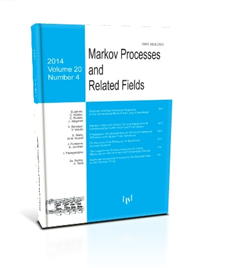Approach to Equilibrium for Kac Master Equation
E. Janvresse
2002, v.8, Issue 2, 221-232
ABSTRACT
We consider the random walk on $S^{n-1}(1)$, the $(n-1)$-dimensional sphere of radius 1, generated by random rotations on randomly selected coordinate planes i,j with $1 \le i < j \le n$. This dynamics was used by M. Kac as a model for the spatially homogeneous Boltzmann equation. If we assume that the initial distribution is of product form, Kac proved that this property remains valid for all time in the limit $n \rightarrow \infty$. In modern terminology, Kac proved the "propagation of chaos". Once propagation of chaos is proved, it is straightforward to show that the marginal density of a particle satisfies the analog of a Boltzmann equation. Clearly, the spectral properties of the collision operator of the Boltzmann equation is of critical importance to understand it. Since this collision operator is generated by a Kac process, a very basic property is the size of the spectral gap, which Kac conjectured to be of order $1/n$. After recalling the idea of the proof of the Kac conjecture and the generalization to the same walk on $SO(n)$, we discuss other ways of measuring the rate of convergence to equilibrium for the Kac master equation (L.S.I., entropy dissipation bound).
Keywords: convergence to equilibrium,spectral gap,Kac model,Boltzmann equation
COMMENTS
Please log in or register to leave a comment

